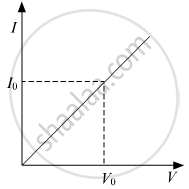Advertisements
Advertisements
प्रश्न
Answer the following question.
While studying the dependence of potential difference ( V) across a resistor on the current (I) passing through it, in order to determine the resistance of the resistor, a student took 5 readings for different values of current and plotted a graph between V and t. He got a straight line graph passing through the origin. What does the straight-line signify? Write the method of determining the resistance of the resister using this graph.
उत्तर

The straight-line graph between the potential difference ( V) and current(I) shows that resistor is a linear element and follows Ohm's Law.
Calculation of Resistance: At any point on the graph, resistance is given as,
`"R" = ("V"_° ("value of potential difference at that point"))/("I"_° ("value of current at that point"))`
In other words, the Slope of the graph at any point gives the value `1/"R"`
Hence,
slope `="I"_°/"V"_° = 1/"R"`
`⇒ "R" = 1/"slope" =( "V"_° ("Value of Potential difference at that point"))/("I"_° ("Value of current at that point"))`
APPEARS IN
संबंधित प्रश्न
A battery of 9 V is connected in series with resistors of 0.2 Ω, 0.3 Ω, 0.4 Ω, 0.5 Ω and 12 Ω, respectively. How much current would flow through the 12 Ω resistor?
When a 4 Ω resistor is connected across the terminals of a 12 V battery, the number of coulombs passing through the resistor per second is:
(a) 0.3
(b) 3
(c) 4
(d) 12
How does the resistance of a wire change when:
its length is tripled?
Give the law of combination of resistances in series.
State expression for Cells connected in parallel.
What is a resistance? Define it with respect to Ohm’s law,
Six resistances are connected together as shown in the figure. Calculate the equivalent resistance between points A and B.

In an electrical circuit, two resistors of 2 Ω and 4 Ω respectively are connected in series to a 6 V battery. The heat dissipated by the 4 Ω resistor in 5 s will be ______.
